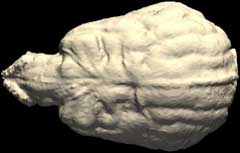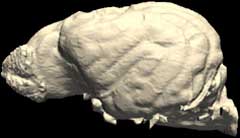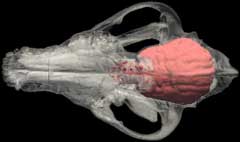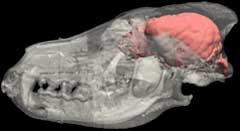|
|
|
Canis lupus, the gray wolf, arose in Eurasia about 1 million years ago, becoming one of the most widely distributed mammals by the end of the Pleistocene. A highly mobile predator with a complex social structure, Canis lupus has evolved to survive in a variety of habitats – from coniferous forests and frozen tundra to arid deserts. It preys primarily upon large ungulates (deer, elk, moose), but may take rabbits and rodents as well as carrion. |
The gray wolf historically ranged throughout the Northern Hemisphere north of 15 degrees latitude. It has been extirpated from most of the continental United States, Europe, southeast China, and Indochina. It is listed on CITES Appendix I for India, Pakistan, Bhutan, and Nepal, and on Appendix II everywhere else. In North America, the gray wolf is endangered in Mexico and the 48 conterminous states of the U.S. except for Minnesota, where it is threatened. Conservation efforts are attempting to combat habitat destruction, competition with humans for livestock, hybridization with domestic dogs, and persecution because of public misunderstanding of the nature of the gray wolf.
Data from CT scans of the skull and jaws of Canis lupus provide important information that complements studies of the phylogeny of canid carnivorans as well as investigations of feeding behavior and domestication. The skulls of Canis (wolves, coyote, jackals), Cuon (dhole), and Lycaon (African wild dog) exhibit a large frontal sinus that invades the post-orbital process of the frontal bone. In the gray wolf this sinus extends caudally to the frontal-parietal suture (see the slice movies or java slice viewer above). |
|
Based on discriminant analyses of skull characters, the domestic dog (Canis lupus familiaris) is morphologically distinct from other canids except for the wolf-like canids (Canis, Cuon, Lycaon). This is not surprising given that several populations of the gray wolf lineage gave rise to the domestic dog. CT analyses of skulls of gray wolves from Japan (C. l. hodophilax) demonstrate a less developed and dorso-ventrally compressed frontal sinus as compared to that of the Akita-Inu breed of domestic dog. It appears that the frontal sinus in domestic dogs conforms to the marked cranio-facial angle ("stop") of the frontal bone. Some populations of Arctic wolves (C. l. arctos) hybridized with domestic dogs of the husky breed in the 1930’s and 1940’s; this is documented in both cranial morphology and historical records. Wolves from this period exhibit relatively smaller skulls with a shortened rostrum, smaller teeth, and a wider occiput.
Radiographic and mechanical analyses of the dentaries of Canis lupus indicate that the jaws of the gray wolf are designed for relatively quick killing bites and bone crushing with the post-carnassial molars. Field observations of prey capture and consumption support these findings.

About the Species
About this Specimen
The specimen was scanned by Matthew Colbert on 11 May 2000 along the coronal axis for a total of 457 slices, each slice 0.5 mm thick and with an interslice spacing of 0.5 mm.

About the
Scan
Literature
Biknevicius, A. R., and C. B. Ruff. 1992. The structure of the mandibular corpus and its relationship to feeding behaviours in extant carnivorans. Journal of Zoology (London) 228:479-507.
Clutton-Brock, J., A., C. Kitchener, and J.M. Lynch. 1994. Changes in the skull morphology of the Arctic wolf, Canis lupus arctos, during the twentieth century. Journal of Zoology (London) 233:19-36.
Ginsberg, J. R., and D. W. Macdonald. 1990. Foxes, wolves, jackals, and dogs: An action plan for the conservation of canids. IUCN, Gland, Switzerland. 116 pp.
Hideki, E., O. Iwao, Y. Tomohiro, K. Masamichi, H. Yoshihiro, and S. Naoki. 1997. Osteometrical and CT examination of the Japanese wolf skull. Journal of Veterinary Medical Science 59:531-538.
Huxley, T. H. 1880. On the cranial and dental characters of the Canidae. Proceedings of the Zoological Society of London 16:238-288.
Ivanoff, D.V. 2000. Origin of the septum in the canid auditory bulla: Evidence from morphogenesis. Acta Theriologica 45:253-270.
Mech, D. L. 1970. The wolf: The ecology and behavior of an endangered species. University of Minnesota Press, Minneapolis. 384 pp.
Mech, D. L. 1974. Canis lupus. Mammalian Species 37:1-6.
Nowak, R. M. 1979. North American Quaternary Canis. Monograph of the Museum of Natural History, University of Kansas 6:1-154.
Kurtén, B. 1968. Pleistocene mammals of Europe. Aldine Publishing Company, Chicago. 317 pp.
Kurtén, B., and E. Anderson. 1980. Pleistocene mammals of North America. Columbia University Press, New York. 442 pp.
Tedford, R. H., B. E. Taylor, and X. Wang. 1995. Phylogeny of the Caninae (Carnivora: Canidae): The living taxa. American Museum Novitates 3146:1-37.
Tedford, R. H., X. Wang and B. E. Taylor. 2001. History of the Caninae (Canidae). Journal of Vertebrate Paleontology 21:107A.
Vilà, C., I. R. Amorim, J. A. Leonard, D. Posada, S. J. Castroviejo, F. Petrucci-Fonseca, K. A. Crandall, H. Ellegren, and R. K. Wayne. 1999. Mitochondrial DNA phylogeography and population history of the grey wolf Canis lupus. Molecular Ecology 8:2089-2103.
Wayne, R. K. 1986. Cranial morphology of domestic and wild canids: The influence of development on morphological change. Evolution 40:243-261.
Young, S. P., and E. A. Goldman. 1944. The Wolves of North America (in two parts). Dover Publications, Inc., New York. 636 pp.
Links
Mammalian Species account of Canis lupus (American Society of Mammalogists)
Canis lupus lycaon on The Animal Diversity Web (The University of Michigan Museum of Zoology)
Canis lupus on The Mammals of Texas Online Edition
The brain of Canis lupus (Comparative Mammalian Brain Collections website)
Canis lupus on the IUCN Canid Specialist Group website
Canis lupus on The Large Carnivore Initiative for Europe website
International Wolf Center website

Literature
& Links
Endocast imagery produced by Ms. Holly Nance, July 2001.
 |
Click on the thumbnail to the left for an animation (2 mb) of the Canis lupus lycaon cranial endocast rotating around the y-axis. |

 |
Click on the thumbnail to the left for an animation (1.7 mb) of the Canis lupus lycaon cranial endocast rotating around the x-axis. |

 |
Click on the thumbnail to the left for an animation (1.8 mb), rotating around the x-axis, of the Canis lupus lycaon cranial endocast highlighted in red within the skull, which is rendered semi-transparent. |

 |
Click on the thumbnail to the left for an animation (1.7 mb), rotating around the y-axis, of the Canis lupus lycaon cranial endocast highlighted in red within the skull, which is rendered semi-transparent. |

For more endocast imagery, please visit the feral domestic cat and bottlenose dolphin pages under their respective "Additional Imagery" tabs.

Additional Imagery
 |
|

